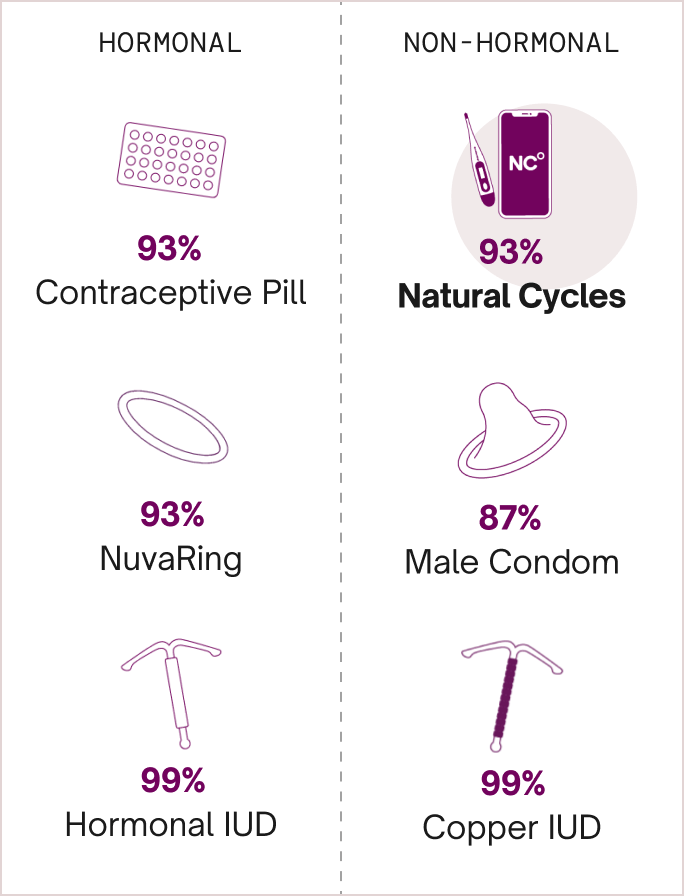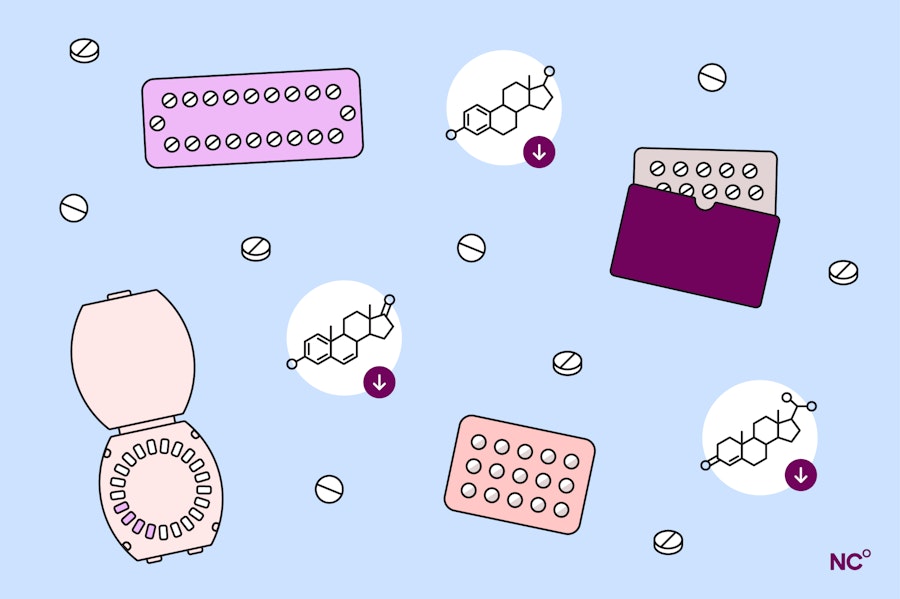Lower dose birth control: What you need to know
Follows NC° Editorial Policy
At Natural Cycles, our mission is to empower you with the knowledge you need to take charge of your health. At Cycle Matters, we create fact-checked, expert-written content that tackles these topics in a compassionate and accessible way. Read more...
Key takeaways:
- Low-dose birth control comes with some risks and side effects, though these vary from person to person
- Low-dose contraceptives usually have milder side effects than standard-dose birth control pills
- Choosing the right birth control option for you will depend on a lot of factors, but IUDs, implants, or non-hormonal options are some alternatives you might want to consider
On this page
- How low-dose birth control works
- High-dose vs low-dose birth control
- The benefits of low-dose birth control
- What are the side effects of low-dose birth control?
- Other risks of low-dose birth control pills
- Other low-dose birth control methods
- What hormone-free options are there?
- The importance of birth control choice
There are more options to prevent pregnancy now than ever before, with low-dose birth control remaining one of the most popular choices. Making a decision about what works best for you can be tricky, and depends a lot on your own circumstances and experience. In this article, we will dive into the benefits and risks of low-dose birth control and introduce some of the alternatives, so you can make an informed decision about what kind of contraception is right for you.
Humans have been trying to solve the riddle of pregnancy prevention for a long time, but medical advances in the last century mean we are fortunate to have a lot of options to suit different lifestyles and preferences.
Of all the options available, low-dose birth control is one of the most common types of contraception: it’s relatively cost-effective, non-invasive, and widely available. Low-dose typically refers to birth control pills where the dose of hormones is less than 35 micrograms or less, sometimes as low as 10 micrograms.[1]
How low-dose birth control works
There are two main types of low-dose birth control pill, the more commonly known combination pill (containing both estrogen and progestin), one containing just progestin commonly known as the mini pill. Progestin is a synthetic form of progesterone, a hormone that normally regulates the menstrual cycle.
In a natural menstrual cycle, progesterone levels fluctuate. After ovulation, the hormone rises sharply as the temporary structure formed on the ovary called corpus luteum produces progesterone to prepare the uterine lining for potential pregnancy. If pregnancy doesn't occur, progesterone levels drop, and you get your peroid.
This rise and fall of progesterone levels are essential for regulating the cycle and maintaining reproductive health. However, with progestin-based contraceptives, this natural fluctuation is bypassed, as progestin provides a consistent level of hormone to prevent pregnancy, rather than mimicking the body's normal cycle of ups and downs..
Generally, the combined pill is more commonly prescribed. However, some people, such as those living with obesity or aged over 35 and who smoke, are advised against taking the combination pill. [2] In addition, certain health conditions such as blood clots, cardiovascular disease (including narrowed arteries), heart problems or migraines with warning signs called aura, can mean you need to steer clear of estrogen, so the mini pill is often prescribed as an alternative. [2,3]
The combination pill works by preventing ovulation through a daily dose of 10-35 micrograms of estrogen, which inhibits the body’s natural signals that trigger ovulation. The body reacts to the pill in other ways too, such as thickening the mucus in the cervix (making it harder for sperm to swim) and thinning of the lining of the womb. [4,5]
With perfect use the combined pill is more than 99% effective, with typical use (how a method is used in the real world) it’s 93% effective. [6] Some common combination low-dose birth control brand names include:
- Ortho-Novum
- Yaz
- Yasmin
- Aviane
- Apri
- Levlen
- Microgestin
- Mircette
Unlike the combined pill, the mini pill relies more heavily on the thickening of cervical mucus and changing the endometrial environment while suppressing, but not completely preventing, ovulation.
Around 40% of women continue to ovulate while taking some kinds of mini pill, though this does not impact the likelihood of pregnancy, as it is also 93% effective with typical use and more than 99% with perfect use. [7, 8] Some common brand names include:
- Camila
- Ovrette
- Norethindrone
- Micronor
- Heather
- Errin
- Nor-QD
High-dose vs low-dose birth control
The original formulations of birth control that were first approved in the early 1960s contained doses as high as 150 micrograms of synthetic estrogen, but in the ensuing decades, successful trials showed that much lower doses had similar outcomes in terms of preventing pregnancy, with milder side effects. By the end of the 1980s 80% of birth control pills prescribed were the low-dose variant. [9]
The benefits of low-dose birth control
As well as preventing pregnancy, taking low-dose birth control pills can offer some additional benefits that may be appealing. These include:
- Potential reduction of heavy periods and severe menstrual cramping [10]
- Improving some kinds of acne with long term use [11]
- Smaller chance of ovarian cysts[12]
- Using birth control can be linked to a lower risk of some cancers including endometrial and ovarian[13]
- Milder symptoms of endometriosis when used continuously (not taking a break between pill packets, or inserting new rings or patches) [14]
For those who have suffered with heavy periods and cramping, taking the pill can have a transformative effect. Research shows that it's safe to run some types of pill packs together], which means you could also be reducing the frequency of your periods to once every three months. [15]
What are the side effects of low-dose birth control?
The mini pill containing only synthetic progestin and the combination pill with both progestin and estrogen, have slightly different side effects, but some of the common symptoms include
- Spotting or breakthrough bleeding
- Not having periods if taken continuously
Some people report the following when taking oral contraceptives:
- Sore breasts
- Nausea
- Headaches [16]
A very rare but serious side effect of taking the combination pill is that your chance of getting blood clots is slightly higher. This is related to your medical history and your doctor will ask you questions to assess the risk before prescribing the combined pill. [17]
Known side effects for low-dose birth control are usually milder than for high-dose birth control pills. Each person’s body reacts differently to the hormones in the pill, and side effects can vary a lot from person to person as well as between different brands. Often, people need to try several different brands of pill to find the one whose side effects are most manageable for them
As a general rule, healthcare practitioners will often advise waiting 2-3 months for side effects to settle down before recommending a change to your prescription. That said, if you are experiencing side effects that are having a significant impact on your quality of life, it is definitely a good idea to talk to your healthcare practitioner to consider other options.
Other risks of low-dose birth control pills
No birth control method is 100% effective, but it’s important to follow the instructions to make sure you get the most out of your chosen contraceptive method. This includes remembering to take the pill at the same time each day. You can do this by setting an alarm, or building it into your routine (e.g. when you brush your teeth or eat breakfast).
If you still think it would be difficult for you to remember to regularly take the pill, it might be worth considering another option such as a hormonal implant or an IUD.
You also need to be aware that if you are unlucky enough to vomit or have diarrhea, you may need to use a secondary birth control method (such as a condoms), as you may no longer be protected. [18]
This is because vomiting or diarrhea can interfere with the absorption of the hormones in oral contraceptives, reducing their effectiveness and increasing the risk of unintended pregnancy. There are also some antibiotics and herbal supplements like St John’s Wort, that can also impact the efficacy of the pill, so talk to your doctor or pharmacist if you are taking other medicines. [19,20]
Another important factor to consider is that no oral contraceptive can protect against STIs (sexually transmitted infections), so using condoms alongside a low-dose birth control pill can offer added protection.
Other low-dose birth control methods
Low-dose birth control doesn’t just apply to birth control pills, although these are some of the most common contraceptives out there. Long-acting methods like the hormonal IUD and implant can be an alternative for those who struggle with high-dose birth control. Both of these methods fall under the category of progestin-only contraceptives. [21, 22]
Typically, long-acting contraceptives release lower hormone levels compared to oral contraceptives, as they remain in the body and gradually release hormones over an extended period.
As with any type of hormonal birth control, you may still experience side effects while using a long-acting method, such as irregular bleeding. [23]

What hormone-free options are there?
Perhaps you have tried some low-dose contraceptives, and they didn’t agree with you, or maybe you don’t like the idea of taking hormones in the first place. There are plenty of reasons why you might want to look into other options, and fortunately, there are other ways to prevent pregnancy without hormones.
Non-hormonal options include the copper IUD, condoms, or using the first FDA Cleared birth control app, Natural Cycles.
The copper IUD (also known as the copper coil) works by releasing copper into the uterus making it a hostile environment for sperm to survive. [24] Some people experience period-like pains after the device is fitted, and your periods may become heavier, longer or more painful while using this type of birth control. The copper IUD is more than 99% effective at preventing pregnancy with both typical and perfect use. [8]
Condoms are easy to access, low-cost or free in some clinics, and as mentioned they are a great choice for STI prevention. Condoms are 98% effective with perfect use, and 87% effective with typical use, meaning that if 100 couples use condoms for a year, on average, 13 couples would become pregnant. [8]
Natural Cycles is the first app of its kind to be cleared for use as contraception by the US FDA and certified in Europe. This temperature-based hormone-free birth control is 93% effective with typical use and up to 98% with perfect use. [25]
Not only will you be aware of where you are in your cycle, you can also monitor emotional and physical symptoms to learn about the changes in your body.
The importance of birth control choice
Many of the factors that play into decisions about which contraceptive method to choose have to do with your own personal preferences as well as how your body reacts to synthetic hormones. For some people, low-dose birth control pills are a good choice, while others might like to explore other options. Whatever you choose, understanding how the different options work is a great way to start.
At Natural Cycles we understand the importance of birth control choice and are proud to offer one more hormone-free option. If you’d like to learn more about your cycle and are looking for a new way to prevent pregnancy, why not find out if Natural Cycles could work for you?
Did you enjoy reading this article?
